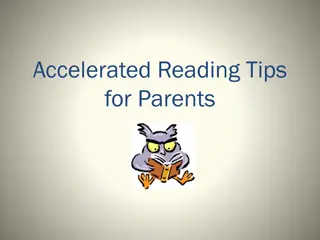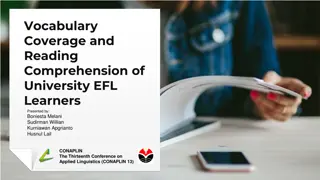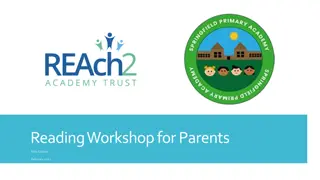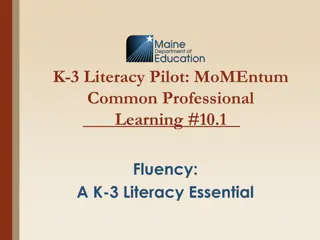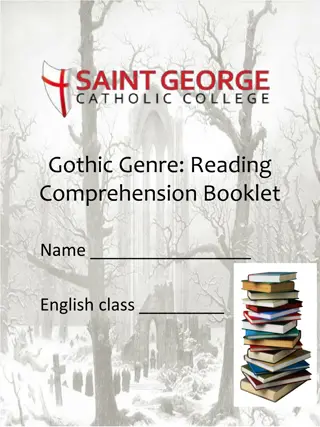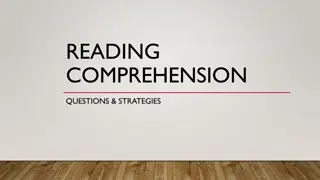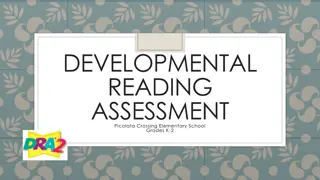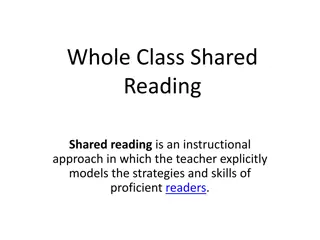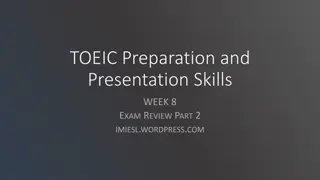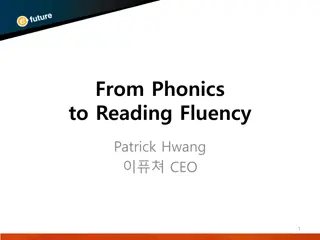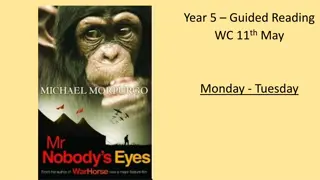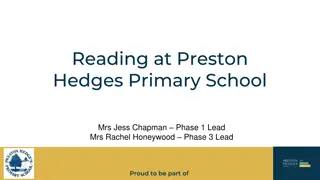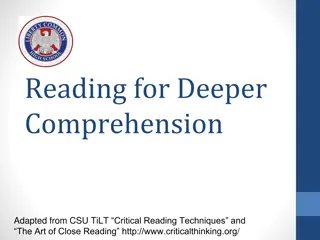TOEIC Reading Comprehension Strategies and Tips
The TOEIC Reading Comprehension section in Week 7 of preparation focuses on Single Passages with various subjects like business, travel, and technology. It includes different formats such as articles, business correspondence, and announcements. The test consists of 29 questions based on 10 texts, with detailed questions and inferences. Strategies include skimming the passage, reading questions first, and referring back for answers. There are 5 types of passages and 4 types of questions to tackle during the test.
Download Presentation

Please find below an Image/Link to download the presentation.
The content on the website is provided AS IS for your information and personal use only. It may not be sold, licensed, or shared on other websites without obtaining consent from the author. Download presentation by click this link. If you encounter any issues during the download, it is possible that the publisher has removed the file from their server.
E N D
Presentation Transcript
TOEIC Preparation Week 7
Part VII: Reading Comprehension Single Passages 29 questions 10 texts, 2-4 questions each Multiple passages 25 questions 5 sets of texts, 5 questions each 1 to 3 related texts to read before answering 3 to 4 sentences, 300 word passages Subjects: business, travel, trade, entertainment, technology, etc Different formats: business form, email, article, letter, etc Longest part of the test Last part of the test Stay focused
5 Types of Passages Articles Business Correspondence Advertisements Announcements Non-prose readings **Multiple passages
4 Types of Questions Overview questions Detail questions Vocabulary questions Inference questions
Strategies 1. Look at the passage quickly to get an idea of what it is about. 2. Read the questions about the passage. You should not read the answer choices at this time. Try to keep these questions in the back of your mind as you read the passage. 3. Read the passage. Try to read quickly, but read every word; don t just skim the passage. Look for answers to the questions that you read. 4. Answer the questions. For detail and inference questions, you will probably have to refer back to the passage.
Strategies 5. In the multiple passages section, remember that you must look at both readings to find the answer for at least one of the questions. 6. If you are unsure of the answer, eliminate answer choices that are clearly wrong, and then guess. 7. Don t spend too much time on any item. If you find a question or even an entire passage confusing, guess, and/or come back to them if you have time. 8. If you have not answered all the questions, and only have a few minutes left, read the remaining questions without reading the passages, and choose the answers that seem most logical.
Passage Type 1: Articles Brief articles or parts of articles Could be found in newspapers or magazines Topics: Business, surveys, studies, etc Overview Questions: Main point of the article Author s opinion or background What type of reader would be interested in the article Where the article was probably published Detail Questions: Specific points made in the article May have to interpret numbers that appear in the article
Passage Type 1: Articles Example Go ahead, have a cheeseburger, France s Constitutional Council said recently. The agency that monitors the constitutionality of laws wasn t ruling on nutrition but on linguistics. Its decision substantially weakens a recent law meant to stop the invasion of foreign words into the French language. That law banned the use of English in broadcasting, advertising, and science. The law would have, for instance, forced restaurateurs to advertise hamburgers au fromage instead of cheeseburgers. However, the Council ruled that the law encroached on the fundamental liberty of thought and expression guaranteed by the French constitution.
Passage Type 1: Articles Example 1. What is this article mainly about? A. The passage of a new bill B. A breakthrough in research C. An invasion of foreigners D. The weakening of recent law 2. Which of the following is closest in meaning to the word monitors in paragraph 2? A. Reviews B. Proposes C. Rejects D. inspires
Passage Type 1: Articles Example 3. The members of the Council are probably experts in which of these fields? A. Nutrition B. Advertising C. Law D. Linguistics 4. How will the owners of restaurants in France be affected by this ruling? A. They can now serve hamburgers with cheese. B. They must now use only French words on menus. C. They may now use English words in advertisements. D. They no longer must serve only French foods.
Passage Type 1: Articles Example 5. Why did the council make this decision about the law? A. Because so many people objected to the law B. Because the law was believed to violate the constitution C. Because the restaurant owners were unhappy with the law D. Because the law did not have its intended effect
Passage Type 2: Business Correspondence Communications sent to or from a business, ie: business letter, interoffice memos, faxes, emails Scheduling a meeting Asking for a report Discussing a problem Thanking someone for a job well done Requesting help or information Usually ask about the purpose of the communication, generally stated in the first paragraph Answers to detail questions are usually found in the body of the communication, but can also be found in the heading or opening.
Passage Type 2: Business Correspondence Example THE RICHMOND HOTEL Warren Purcell, Convention Chair American Association of Photoengravers North Central District 621 Plum Street, Suite 28 Detroit, Michigan 48201 Dear Mr. Purcell: Mr. Scarlotti, our general manager, passed on your letter requesting information regarding our convention facilities and asked me to respond. I am happy to comply.
Passage Type 2: Business Correspondence Example As you can see from our brochure, we offer large meeting rooms for plenary sessions and display areas, and an ample number of small breakout rooms for workshops and concurrent meetings. Banquet facilities are also available. Our centralized location is convenient to other hotels, fine restaurants, and all the sights of downtown Chicago, as you can see from the map I ve seen. I m also enclosing a list of special room rates for convention attendees. I think you will find the Richmond Hotel the perfect host for your convention. Our experienced and courteous staff really knows what it takes to make a convention run smoothly. Please let me know if there is any other information or help I can provide. Sincerely, Diana Lockhurst Diana Lockhurst, Convention and Banquet Manager Encl: (3)
Passage Type 2: Business Correspondence Example 1. What is the main purpose of this letter? A. To ask for further information B. To respond to a request C. To confirm a reservation D. To explain the general manager s opinion 2. Which of the following is NOT enclosed? A. A schedule of events B. A publicity brochure C. A map of downtown Chicago D. A list of room rates
Passage Type 3: Advertisements Commercial advertisements you might see in newspapers and magazines Classified ads, help wanted ads, positions wanted ads, business available ads, etc Overview questions generally ask what is the purpose of the ad is or where this ad probably appeared. Detail questions often ask about the price of an item that is offered or about the time or place goods or services are available.
Passage Type 3: Advertisements Example OWNING A FRANCHISE CAN BE MAGICAL! The expanding children s service market offers an excellent return on your investment and puts a little magic into your summer. Summer Magic Day Camps franchises provide door-to-door pick-up services for children (ages 6-13) and a wide variety of activities in parks and other locations. No need to invest in expensive camp facilities, as all activities are held off- premises. You can operate the business part-time and from home. We provide all the know-how and direction needed for start-up and day-to-day operations. Very reasonable franchise fees.
Passage Type 3: Advertisements Example 1. For whom is this advertisement intended? A. People who want to operate their own business B. Parents of young children C. People who own summer camps D. People who want to work as camp counselors 2. The company placing this advertisement would probably NOT provide information on which of the following? A. Where to hold activities B. What kind of activities to provide C. How to attract campers D. How to purchase a site for the camp
Passage Type 4: Announcements Announcements and notices are brief readings meant to inform the public. They concern: the hours of a new business, the introduction of a new product or service, the availability of a business opportunity, the statement of a government or business policy, the opening of a cultural attraction, and other similar situations Overview questions often ask about the purpose of the announcement or the audience for it. Detail questions often ask about time, place, and price.
Passage Type 4: Announcements Example American Impressionism and Realism: The Paintings of Modern Life, 1885-1915. This display features more than 80 paintings that contrast two important turn-of-the-century schools of art. Featured artists include impressionists John Singer Sargent and Mary Cassatt and realists Robert Henri, John Sloan, and William Blackins. At the Los Angeles Museum of Art until May 24.
Passage Type 4: Announcements Example 1. What is the main theme of this display? A. The range of contemporary painting in Los Angeles B. The contrast between today s art and turn-of- the-century art C. Paintings produced by students from two universities D. Differences between two important styles of art 2. Which of the following artists is NOT considered a realist? A. John Sloan B. Mary Cassatt C. Willam Blackins D. Robert Henri
Passage Type 5: Non-Prose Readings Not written in standard paragraph style and may not employ complete sentences. Forms (especially those used by businesses), lists, charts, graphs, schedules, and maps. Unlike other types of passages, you should not read non-prose readings word for word. Take a quick glance at the reading to get and overall idea, and then start working on the questions. Refer back to the reading to find the specific information.
Passage Type 5: Non-Prose Readings Example METRO LODGING REPORT: JULY Room Nights Occupancy Percentage Average Room Cost Location Occupied Available AIRPORT 89,649 104,847 85.5% $98.28 NORTH SUBURBAN 29,686 35,065 84.7% $73.75 WEST SUBURBAN 46,279 50,950 90.8% $87.78 MIDTOWN 29,681 37,851 78.4% $69.70 DOWNTOWN 62,620 77,271 81.0% $119.61
Passage Type 5: Non-Prose Readings Example 1. What does this report concern? A. Apartment buildings B. Hotels C. Parking lots D. Office buildings 2. Which area had the highest rate of occupancy in July? A. North Suburban B. Airport C. West Suburban D. Downtown
Passage Type 5: Non-Prose Readings Example 3. What information does the chart provide about Downtown? A. On average, it had the most expensive rooms. B. It had fewer empty rooms in July than Midtown did. C. It had more rooms than any other area. D. There were more rooms per building than in other areas.
Multiple Readings Two or three related texts Combination of: a letter, a memo, an ad, a schedule, a chart, a business form, an email, a personal note, etc Overview questions usually ask about the purpose of one of the passages. Detail questions may ask about specific points in any of the readings At least 1 question in each set, and often 2 or 3 questions, requires you to look at two or all readings in order to answer the question. You will probably see a vocabulary question as well. 5 questions per set


